Bonhams Hong Kong 2011 Spring Auctions: Fine Chinese Ceramics and Works of Art
A rare and brilliantly enamelled ruby-ground 'yangcai' 'floral' bowl. Yongzheng yuzhi four-character mark and of the period. Photo: Bonhams
HONG KONG.- The Fine Chinese Ceramics and Works of Art auction features a cornucopia of works of art from the sublime to niche collectibles, reflecting the rich diversity of China's Imperial and artistic output.
The sale includes several private collections of fine quality Chinese antiques, including:
Chinese Jades from the Collection of John and Berthe Ford
The collection of John and Berthe Ford is famous for its Himalayan art, one of the most important private collections in the world. The collection has been widely exhibited, including at "Desire and Devotion: Art from India, Nepal and Tibet", which was shown between 2001 and 2004 at the Walters Art Museum, Santa Barbara Museum of Art, Albuquerque Museum of Art, Birmingham Museum of Art, and Hong Kong Museum of Art. In an extraordinary act of philanthropy, the Fords have recently donated their entire collection to the Walters Art Museum, their home museum in Baltimore.
The name Ford is famous in Himalayan art, but only close friends and relatives would have been aware of the collection of Chinese decorative art begun by his godfather Edward O'Dell in the 1930s, and continued right up to the present day by his protégée. Many of the larger vessels at the Bonhams auction were purchased by O'Dell at the great liquidation sale of Yamanaka & Co., held at Parke-Bernet Galleries, New York, from 24-27 May 1944. The others were acquired by O'Dell and Ford from galleries they visited on their extensive international travels.
Collection of Bronze Weapons
This is an extraordinary comprehensive collection of 207 ancient Chinese bronze weapons, formed by a Western connoisseur, resident in Hong Kong, over a 20-year period. The highlights of the collection were included in the groundbreaking exhibition 'Ancient Chinese Weapons' at the Museum of Coastal Defense, Hong Kong. The collection will be sold without reserve.
Julian King, Head of Chinese Ceramics and Works of Art, comments: "This is a unique auction in Hong Kong as auctions normally focus on antiques from the Ming and QIng dynasties. The owner has taken the decision to offer the weapons without reserve, which provides an unparalleled opportunity for collectors to purchase ancient bronze weapons with outstanding provenance. Some of the Warring States swords would be sold for up to US$50,000 on the international market, making this an auction not to be missed for collectors interested in Chinese ancient bronzes".
Highlights include:
• A rare and brilliantly enamelled ruby-ground 'yangcai' 'floral' bowl Yongzheng yuzhi four-character mark and of the period Estimate HK$2,000,000-4,000,000
A rare and brilliantly enamelled ruby-ground 'yangcai' 'floral' bowl. Yongzheng yuzhi four-character mark and of the period. Photo: Bonhams
Extremely finely potted, with shallow rounded sides rising from a short straight foot, delicately painted in brilliant 'yangcai' enamels, the details picked out in black, with chrysanthemum, mallow, various peonies, yellow day lily and various other flowers, all reserved on a rich ruby-red ground, the interior and base glazed white, the base inscribed with the four-character mark in underglaze-blue within a double square. 9.1cm diam. Estimate: HK$2,000,000 - 4,000,000, US$ 260,000 - 510,000
清雍正 胭脂紅地洋彩花卉紋小碗 方框青花「雍正御製」楷書款
Provenance來源: Sotheby's New York, 17 October 2001, lot 169
A bowl of almost identical size and design from the Qing Court collection, preserved in the National Palace Museum, Taipei, is illustrated in Harmony and Integrity: The Yongzheng Emperor and His Times, Taipei, 2009, pg. 215, pl. II-41 (fig.1), and discussed by Yu Peijin, who expounds that the ruby-ground enamel on the bowl is exactly that recorded as 'xiyang hongse' (literally 'Western red') on the Taocheng jishi pei, the calligraphy written on the death of Tang Yin, the Imperial supervisor of porcelain at Jingdezhen from 1728-1756.
See also a bowl in the British Museum, London, illustrated in Hugh Moss, By Imperial Command, Hong Kong, 1976, pl.5; and a bowl in the Victoria and Albert Museum, London, illustrated by Rose Kerr Chinese Ceramics: Porcelain of the Qing Dynasty, London, 1986, pl.93. For a similar bowl bearing a Yongzheng yuzhi bowl sold at auction, see a slightly smaller example from the T.Y. Chao collection, sold at Sotheby's Hong Kong, 18 November 1986, lot 130.
• An extraordinary pair of large exquisitely carved ivory vases from the late Qing dynasty Estimate HK$1,800,000 - 2,500,000
An extraordinary pair of large exquisitely carved ivory vases. Late Qing dynasty. Photo: Bonhams
Each of square section and carved from many conjoint pieces of ivory, the large baluster-shaped vase with gently tapering sides and four vertical panels, exquisitely carved in high-relief with extensive scenes of deities and figures travelling or engaging in leisurely pursuits: one vase with a male deity riding on a twin-wheeled carriage pulled by a dragon with his entourage, a female deity walking amongst clouds with attendants demounting her palanquin carriage pulled by three dragons, a male deity riding on a Buddhist lion holding a lotus spring with his entourage, a group of deities bringing forth magical gifts, the gourd spewing-forth a cloud of smoke with three bats; the other vase with the Queen Mother of the West, Xiwangmu, arriving and greeted warmly at her abode in the Kunlun Mountains riding on a phoenix with attendants carrying a peach box with the fruits of longevity, a scene of three male deities as guests indulging in provisions well-served by female attendants, an old male deity travelling on a dragon with his band of followers, three male deities warmly greeted at the reception by a group of female attendants bearing baskets of flowers, the towering vase standing firm on four sturdy feet, rising to a stepped shoulder and a straight neck, flaring to a straight everted lip, the neck flanked by a pair of heavenly apsaras holding baskets of flowers and a pair of taotie handles suspending loose rings, the cartouches framed by intricately carved auspicious objects bajixiang, all on an archaistic geometric ground with stylised lotus scrolls. 42.5cm high. (2). Estimate: HK$1,800,000 - 2,500,000, US$ 230,000 - 320,000
晚清 象牙雕蟠桃宴花瓶一對
• An outstanding white jade 'hu' vase from the Qianlong period. HK$800,000-1,200,000
A superb white jade 'landscape' vase and cover, hu. Qianlong. Photo: Bonhams
The even white stone intricately worked in the form of a flattened hu-shaped vase, rising from a splayed foot to high shoulders, the waisted neck flaring to a galleried rim, surmounted by a plain cover, flanked by a pair of stylised dragon heads suspending loose rings, the body superbly worked with a continuous landscape scene of luxuriant branches of flowers issuing from rockwork, the foot with a keyfret border, the neck worked on each side with a stylised taotie mask, wood stand. 20cm high. (3). Estimate: HK$800,000 - 1,200,000, US$ 100,000 - 150,000
清乾隆 白玉雕連景花林龍耳活環扁瓶
Provenance來源: Edward Choate O'Dell, Baltimore, 1940s
Vases of archaic bronze form fashioned from the finest white nephrite represent the pinnacle of quality in the Qianlong period. Archaism was highly fashionable at the Imperial court, encouraging artisans to utilise archaic motifs such as the 'taotie' mask in the decoration of vessels.
This superb vase derives its shape from an ancient bronze 'hu' vessel, but with much more stylised dragon handles than would be found on an Eastern Zhou bronze vessel. For a white jade vase with similar dragon handles from the Qing court collection, preserved in the Palace Museum, Beijing, see Jadeware (III). The Complete Collection of the Palace Museum, Hong Kong, 1995, pl. 65. See also another closely related white jade 'plum blossom' vase in the Palace Museum, Beijing, illustrated in The Complete Collection of Treasures of the Palace Museum, Shanghai, 2008, pg. 24, pl.18.
The outstanding workmanship on this vase is encapsulated by the skill with which the stone is worked into a continuous scene unfolding around the exterior of the main body, utilising the subtle natural flaws in the stone to dictate the natural contours of the landscape.
• An 18th century large white jade finger-citron from the mid Qing dynasty period Estimate: HK$80,000-120,000
A large white jade 'finger citron'. Mid Qing dynasty. Photo: Bonhams
Naturalistically worked as a cluster of two finger citrons, the natural texture of the fruit captured by the subtle surface bumps and glossy polish of the stone, the larger fruit towering above the smaller, both with elongated thick tendrils with curled ends, all issuing from an openwork of gnarled branches bearing further large lobed leaves worked in high relief, a lone pheasant sitting on a stalk with its head back-turned, the stone pale green with slight light brown russet stains, stand. 19.7cm high. (2). Estimate: HK$80,000 - 120,000, US$ 10,000 - 15,000
清中期 白玉雕佛手瓜形花插
Provenance來源: Edward Choate O'Dell, Baltimore, 1940s
The Buddha's hand citron, which takes its name from the shape of its fruit that resembles the idealised digiform fingers of the Buddha, has a strong fragrance and is used as an altar offering during the New Year celebration. The first character of its name, 'fo', is a pun for 'fu' which translates as blessings or riches, while the second character, 'shou', is a homophone for longevity.
For a related white jade finger citron, see J Watt, Chinese Jades from the Collection of the Seattle Art Museum, Seattle, 1989, pl.79. See also an example in the Asian Art Museum of San Francisco, illustrated by R.L.D'Argencé, Chinese Jades in The Avery Brundage Collection, Tokyo, 1977, pp.106-107, pl.XLVI.
The collection of John and Berthe Ford is famous for its Himalayan art, one of the most important private holdings in the world. The collection has been widely exhibited, including Desire and Devotion: Art from India, Nepal and Tibet, which was shown between 2001 and 2004 at the Walters Art Museum, Santa Barbara Museum of Art, Albuquerque Museum of Art, Birmingham Museum of Art, and Hong Kong Museum of Art. In an extraordinary act of philanthropy, the Fords have recently donated their entire collection to the Walters Art Museum, their home museum in Baltimore.
John Ford began to collect in India and Nepal in 1963, and has consistently visited Asia almost every year with his wife Berthe, sharing their deep love of Asian art, forming the collection which the renowned scholar Pratapaditya Pal, and author of Desire and Devotion describes as 'the outcome of the intense desire and passionate devotion of both Fords'.
John Ford was also profoundly influenced by his godfather and mentor, Edward Choate O'Dell (1901-82), the famous Baltimore collector of Chinese art and founder of The International Chinese Snuff Bottle Society, whose collection was exhibited at the Asia Society, New York in 1982. He was regarded as a 'renaissance' man for his broad interests in engineering, law, music and Chinese art, and a pioneer in the study of Chinese snuff bottles.
The name Ford is famous in Himalayan art, and O'Dell is famous in Chinese snuff bottles, but only close friends and relatives would have been aware of the collection of Chinese decorative art begun by O'Dell in the 1930s, and continued right up to the present day by his protégée. Many of the larger vessels here were purchased by O'Dell from the great liquidation sale of Yamanaka & Co., held at Parke-Bernet Galleries, New York, 24-27 May 1944. The others were acquired by O'Dell and Ford from galleries they visited on their extensive international travels.
Edward O'Dell had an eye for classic, archaic form. This is reflected in his choice of vessels derived from archaic bronze shapes: an Imperial white jade 'guang' vessel (lot 390) with original zitan stand, comparable to an example in the National Palace Museum, Taipei; a rare yellow jade 'fangding' (lot 417), closely related to a spinach jade example in the Palace Museum, Beijing; and the outstanding white jade 'hu' (lot 427). There is also a broad range of carvings encapsulating the diversity of auspicious symbols in Qing dynasty art, including various fruits, lingzhi fungus, auspicious animals, and a large white jade finger-citron (lot 389), emblematic of the Buddha's hands.
約翰與巴馥•福特珍藏中國玉器(Lot 389至Lot 428)
約翰與巴馥•福特所藏的喜馬拉雅藝術被譽爲全球最重要的私人收藏之一,而他們也因此聞名世界。他們的收藏曾在世界各地展出,這包括反響强烈的〈欲望與虔誠:約翰與巴馥•福特藏 印度、尼泊爾及西藏藝術〉展覽。該展覽在2001年至2004年期間,先後於巴爾的摩的沃爾特藝術博物館、加州聖巴巴拉藝術博物館、新墨西哥州阿爾伯克基藝術博物館、亞拉巴馬州伯明翰藝術博物館、香港藝術館等博物館機構展出。不久前,夫婦倆人將其全部收藏品捐獻給了家鄉巴爾的摩的沃爾特藝術博物館,可謂慈善與公益事業中又一曠世之舉。
約翰•福特自1963年便開始在印度及尼泊爾從事文物藝術品收藏活動,並持續每年携妻子巴馥•福特走訪亞洲各個國家。福特夫婦在與衆人分享他們對亞洲藝術鍾愛之情的同時,也不斷擴大了自己的藝術收藏。《欲望與虔誠》一書的作者,著名學者布拉達帕迪亞(Pratapaditya Pal)曾描述福特夫婦的收藏爲「對亞洲藝術熾熱之情及用心投入的碩果」。
約翰•福特在藝術收藏上深受其教父、知名中國藝術收藏家愛德華•喬特•奧戴爾(Edward Choate O'Dell)(1901-82)的影響。奧戴爾可謂是福特在中國藝術品收藏中的良師益友,他創辦了國際中國鼻烟壺協會,他本人的收藏也曾於1982年在紐約亞洲協會展出過。憑藉他對工程、法律、音樂以及中國藝術等方面的廣泛興趣和研究,奧戴爾被譽爲當時的"文藝復興之人",幷被公認爲是當時中國鼻烟壺研究的先驅者。
儘管福特與奧戴爾分別是以其喜馬拉雅藝術及中國鼻烟壺收藏而聞名于世,但與他們較爲親近的朋友和圈內的藏友以及親人都知道,奧戴爾其實從十九世紀30年代就開始收藏其他門類的中國裝飾藝術了。直至今日,奧戴爾的門生仍然對中國藝術品收藏有著濃厚興趣。在奧戴爾的收藏中,多數大件中國藝術品都購自於日本山中産業(Yamanaka & Co.)在1944年位於紐約Parke-Bernet美術館舉行的一次清產核資拍賣。還有另外一部份的藏品,是奧戴爾與福特走訪世界各地時收購而來。
奧戴爾對中國藝術品的收藏可謂是別具慧眼,他獨到而復古的眼光都可從其所挑選的幾件精美的仿古玉彝器中得到印證:一件帶原配紫檀底座的御制白玉觥(編號390),其造型仿製造古代青銅禮器,臺北故宮博物院也藏有與此類似彝爐一件;另外一件黃玉方鼎式爐(編號417)與北京故宮博物院所藏的一件碧玉方鼎爐也極爲相似;還有一件白玉壺(編號427)也可謂是仿古彝器中的典型佳作。除此之外,還有其他一系列帶有吉祥文飾的清代玉雕精品,包括瓜果、靈芝、瑞獸,或是白玉佛手(編號389)等等。
Julian King adds further: "The Fine Chinese Ceramics and Works of Art sale on 25 May contains a rich diversity of material, ranging from ancient bronze swords from the Shang dynasty (12th century BC) to 19th century porcelain. Amongst the 250 lots, there truly is something that that will appeal to a large group of collectors".
Two spear heads and three bronze utility knives. Shang dynasty, Anyang period. Photo: Bonhams
Two bronze spear heads, each with leaf-shaped head and oval socket, the waisted blade at the head then flaring towards the shaft with two piercings, the indented leaf-shaped region corresponding to overall outline (largest 25cm); together with a large bronze utility knife, the thickened spine slightly concave, the flat grip cast in I-beam, the pommel in the form of an L-shape (27cm); a knife with straight beak-shaped blade, the grip decorated with deeply-cast parallel lines terminating with a slightly flattened jingle with openwork containing a bronze bead (27cm); a bronze ritual implement with one side bare with only a ridge pointing down from the guard, the other side decorated with interlocking squared spiral pattern, the grip terminating in a narrow neck and rectangular pommel in the form of an open jaw with two circular eyes and a pattern of triangles (33.5cm). The largest 33.5cm long. (5).
商安陽時期 青銅矛兩件、青銅刀三件
The pair of spear heads represents the standard Shang spear head designs of the Anyang period. A similar spear head was excavated at Dasikong Village, grave number 304. One of the spear heads has a handsome azurite patina; the other with a copper oxide/lead oxide and malachite patina, while the central region is filled with possibly silver oxide.
Public Viewing : 23 May from 1pm to 9pm - 24 May from 10am to 9pm - 25 May from 10am to 11:30am
Venue: Island Ballroom, Island Shangri-La Hotel, Admiralty; Hong Kong

/https%3A%2F%2Fprofilepics.canalblog.com%2Fprofilepics%2F1%2F0%2F100183.jpg)
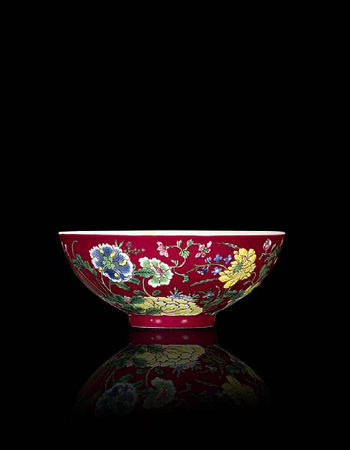



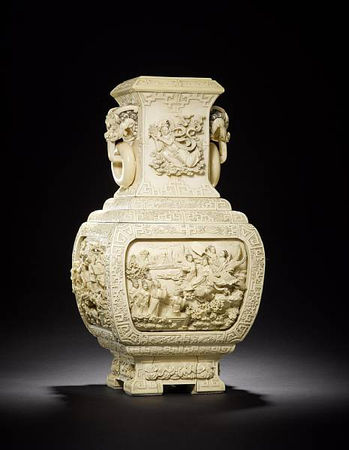
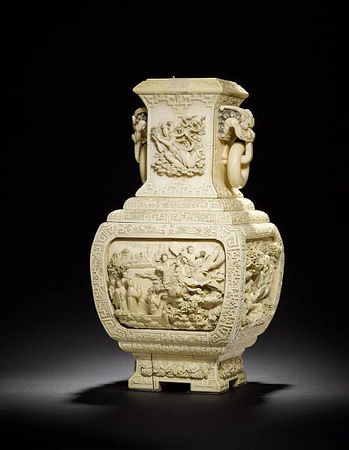
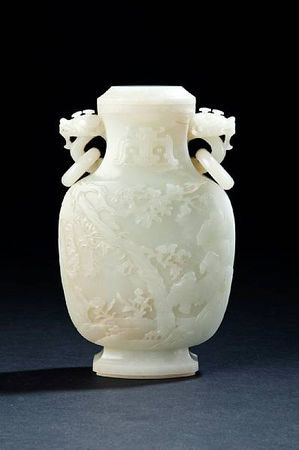


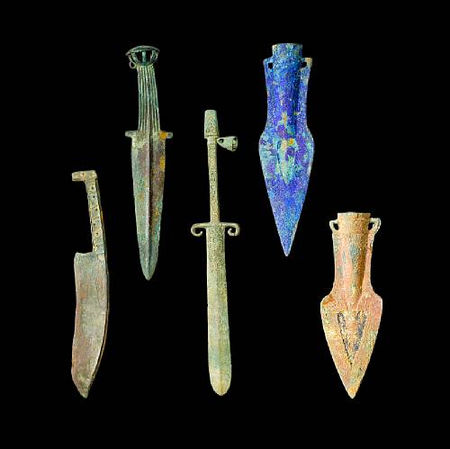


/http%3A%2F%2Fstorage.canalblog.com%2F43%2F34%2F577050%2F65866509_o.jpg)
/http%3A%2F%2Fstorage.canalblog.com%2F89%2F17%2F577050%2F65835561_o.jpg)
/http%3A%2F%2Fstorage.canalblog.com%2F65%2F69%2F119589%2F65765172_p.jpg)
/http%3A%2F%2Fstorage.canalblog.com%2F27%2F67%2F119589%2F65244452_p.jpg)